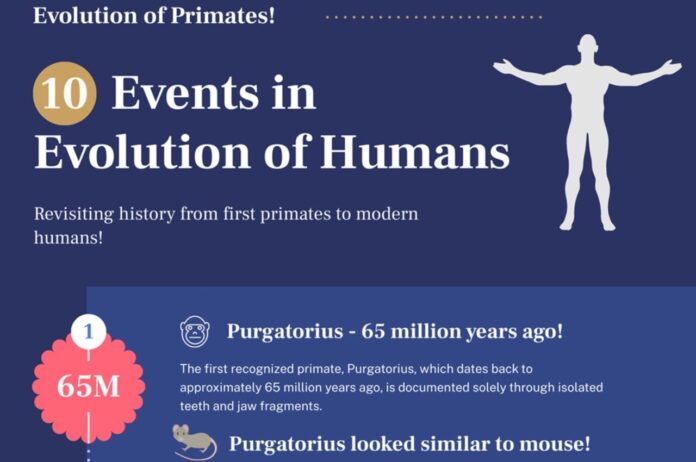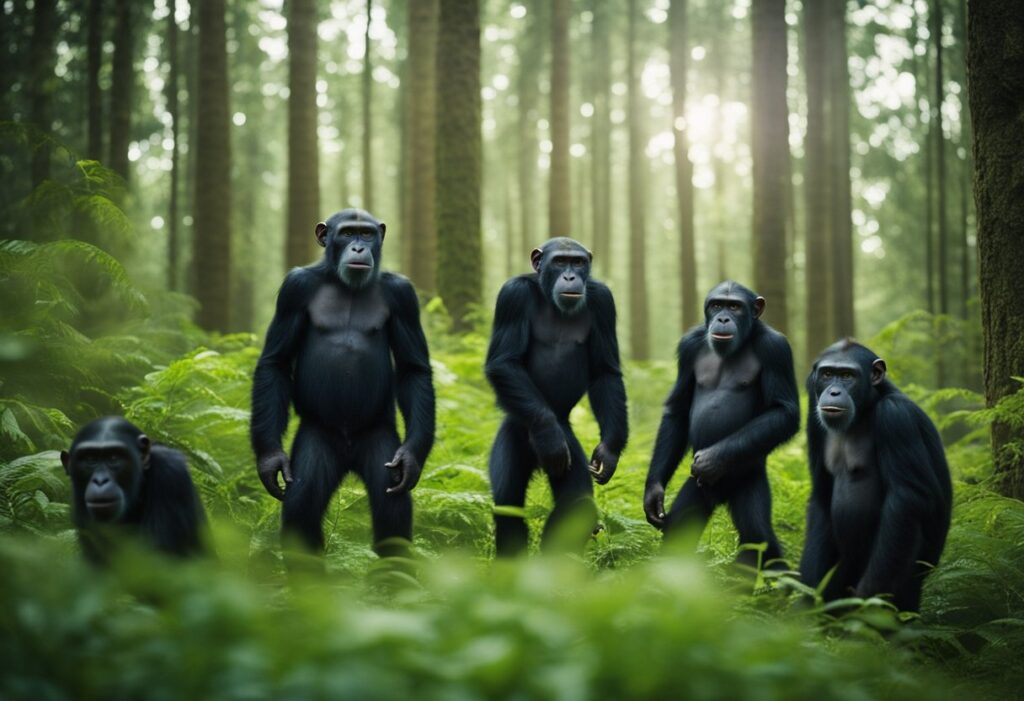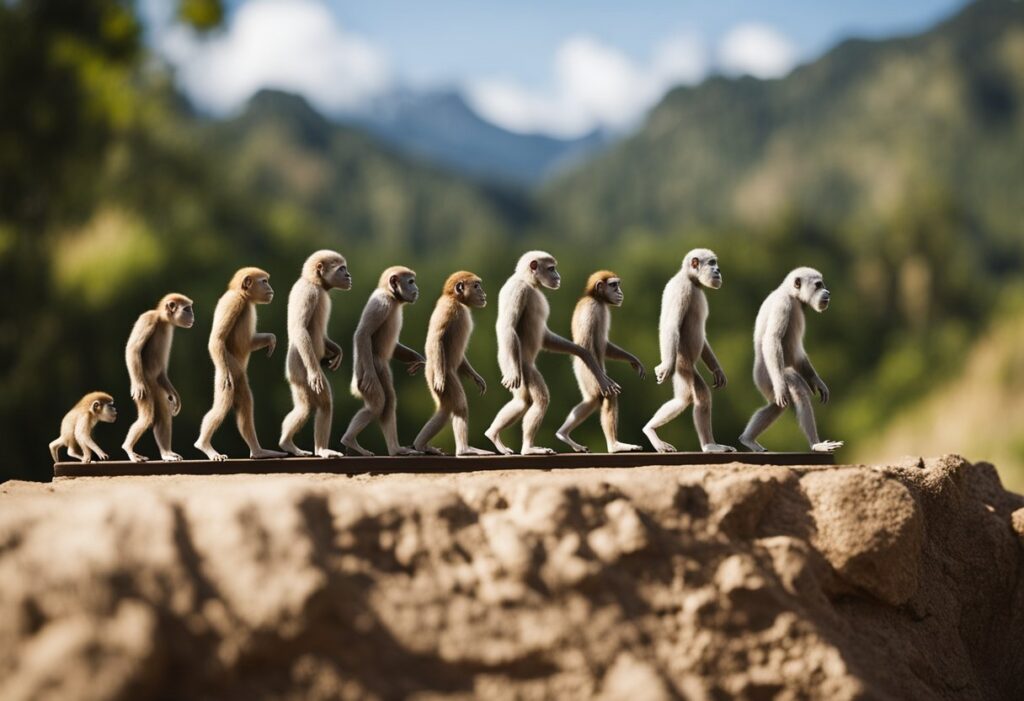
The timeline of human evolution is a rather interesting but complex subject. It is a story that basically begins with with the earliest known primates, such as Dryomomys and continues through the evolution of various species, including Carpolestes, Notharctus, Aegyptopithecus, Proconsul, Dryopithecus, Australopithecus, Homo erectus, and finally, Homo sapiens.
Take me straight to Infographic!
Each step in the timeline represents a significant milestone in the evolution of primates and ultimately, humans.
To offer you a clearer perspective through a visual representation, we have created an infographic that showcases the timeline of primate evolution, culminating in the progression of human evolution.
The infographic highlights the top 10 events and milestones in the evolution of primates. And, as we all know, humans are members of a specific sub-group of mammals known as primates.
Therefore, this infographic essentially depicts the timeline of us—humans and our evolution.
Human Evolution Timeline – Infographic
Click here (or on image) for full size version or if you’d like to download (PDF) infographic and share with your readers.

If you’d like to share this infographic on your site use following embed code:
<p><strong>Infographic created by <a href="https://curiousmatrix.com/infographic-timeline-of-human-evolution/">CuriousMatrix.com</a> team!.</strong> <br /><br /><a href='https://curiousmatrix.com/infographic-timeline-of-human-evolution/'><img src='https://curiousmatrix.com/infographic-timeline-of-human-evolution/noresize-human-evolution/' alt='Human Evolution Infographics' width='696' /></a></p>And so, let’s briefly describe this infographic and top 10 milestones in primate and homo sapiens evolution…
Earliest Primates – Precursors to Primates

Purgatorius
Purgatorius is believed to be one of the earliest primates, dating back to about 65 million years ago. It was a small, tree-dwelling animal that had some primate-like features such as forward-facing eyes and grasping hands and feet. Basically, it looked a lot like a modern-day mouse.
Dryomomys
Dryomomys are examples of early euprimates that lived about 56 million years ago. They were small, tree-living animals with grasping hands and feet, and they likely fed on insects and fruit.
Carpolestes
Then we have Carpolestes. They are an example of a plesiadapiform, a group of mammals that are not considered to be true primates but are related to them. Carpolestes lived about 55 million years ago and had some primate-like features such as grasping/grabbing hands and feet and forward-facing eyes.
After them, Notharctus developed.
Notharctus
Notharctus is an extinct genus of early primates that lived during the Eocene epoch, approximately 45 million years ago. They belong to the family of Adapidae.
These small to medium-sized arboreal creatures possessed a combination of features characteristic of both prosimians and anthropoids, making them rather important in understanding the adaptive pathways leading to the emergence of primates
And so, as time passed, these early primates evolved into more complex and diverse forms, eventually leading to the emergence of the first true primates.
This timeline of evolution (pictured in above infographic) includes several species such as Aegyptopithecus, Proconsul, Dryopithecus, Australopithecus, Homo erectus, and finally – Homo sapiens.
Rise of the First Apes

The evolution of primates began with the emergence of the first prosimians during the Eocene epoch. These early primates were small and arboreal (tree-living), and they had adaptations such as grasping hands and feet, stereoscopic vision, and reduced snouts.
Over time, these primates diversified, giving rise to a variety of forms, including the first apes.
Aegyptopithecus
The first apes emerged during the Oligocene epoch, around 35 million years ago. One of the earliest known apes was Aegyptopithecus, a member of the family Propliopithecidae.
Aegyptopithecus was a small, arboreal ape that lived in what is now Egypt. It had a number of ape-like features, including a short snout, forward-facing eyes, and opposable thumbs.
Early Hominoids: Proconsul and Dryopithecus
The next major group of apes to emerge were the early hominoids (although there is still ongoing discussion if Proconsul can be classified as hominoid), which lived during the Miocene epoch, around 20 to 5 million years ago.
One of the most important early hominoids was Proconsul, which lived in what is now Kenya. Proconsul was a small, arboreal ape that had a number of features that were intermediate between those of apes and Old World monkeys.
For example, it had a relatively long snout (nose) and lacked a tail.
Another important early hominoid was Dryopithecus, which lived in what is now Europe and Asia. Dryopithecus was a larger ape than Proconsul, and it had several ape-like features, including a broad chest and short pelvis. However, it also had some monkey-like features, such as a narrow rib cage.
And so, then in our timeline, we started to witness the emergence of Hominins.
Emergence of Hominins

Hominins are a group of primates that belong to the tribe Hominini, which includes modern humans and our extinct ancestors.
Australopithecus: An Early Hominin
One of the earliest hominins known to science is Australopithecus. This genus of bipedal primates lived between 4 and 2 million years ago in Africa. They are known for their small brains and ape-like features, such as long arms and curved fingers.
Australopithecus is believed to have evolved from an earlier group of bipedal primates called Ardipithecus.
The most famous species of Australopithecus is probably Australopithecus afarensis, which is known for the discovery of the fossilized remains of a female specimen named Lucy.
Lucy’s skeleton provided valuable insights into the anatomy of early hominins, including their bipedalism and their unique adaptations for walking on two feet
Overall, the emergence of hominins represents a major turning point in the evolution of primates.
It marked the beginning of a long process of adaptation and diversification that eventually led to the emergence of modern humans.
Evolution of Homo Genus

Homo Erectus
Homo erectus is believed to have originated in Africa around 2 million years ago and was the first hominid to migrate out of Africa and into Asia and Europe. They were taller and had larger brains than their predecessors, the Australopithecus, and were able to make and use tools more effectively.
Homo erectus also had a more efficient body structure, allowing them to cover greater distances and adapt to a wider range of environments.
One of the most significant findings related to Homo erectus was the discovery of the “Turkana Boy” in Kenya, which is the most complete skeleton of a Homo erectus ever found.
It provided great insights into the physical characteristics and behavior of Homo erectus.
Homo Sapiens: The Modern Human
And finally, in this timeline, we’re arriving at us – humans.
Homo sapiens or modern humans, are believed to have originated in Africa around 300,000 years ago. They are the only surviving species of the Homo genus and have several physical and behavioral characteristics that set them apart from their predecessors.
One of the most notable characteristics of Homo sapiens is their (our) large brains, which are responsible for their advanced cognitive abilities and language skills.
They (we) also have a more upright posture, allowing them to walk and run more efficiently, and have a more complex social structure.
Conclusion

The evolution of primates and Homo sapiens can be interconnected but may also exhibit disconnections in certain aspects. According to the theory of evolution, humans undeniably trace their roots back to early primates like Carpolestes. As these primates evolved into entities resembling today’s monkeys and chimpanzees, we draw closer to our ancestors. Subsequently, as some of these primates transitioned to walking on two legs, we truly approached our closest ancestors, such as Australopithecus.
And so, we hope that our infographic timeline illustrating primate and human evolution enhances your understanding of this fascinating and extensive journey that was necessary for us to be alive today and reading this text.
Recommendation: If you liked this article, you might also like:



























